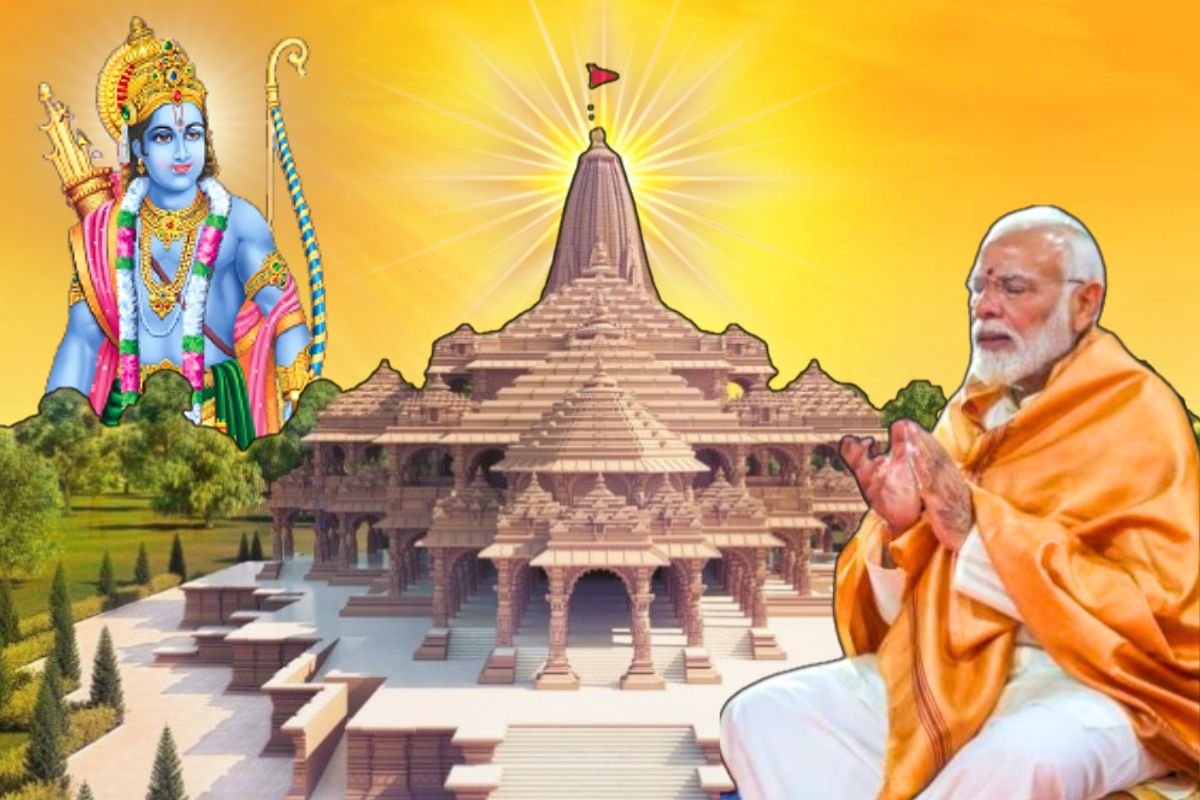The Ram Mandir, also known as the temple of Lord Ram, is a highly venerated and disputed religious location in India. For centuries, Hindus have believed that Ayodhya, a town in Uttar Pradesh, is the birthplace of Ram, the seventh incarnation of Vishnu.
During the 16th century, Babur, the Mughal emperor, destroyed a temple located at the site and constructed a mosque called the Babri Masjid in its stead. This led to a long and bitter dispute between Hindus and Muslims over the ownership and status of the land.
LIVE – Consecration Ceremony of Ram Mandir | Ayodhya Dham | 22nd Jan 2024
In this article, we will trace the history of the Ram Mandir movement, from its origins in the colonial era to its culmination in the Supreme Court verdict of 2019 and the foundation stone laying of 2020. We will also go over the Pran Pratishtha ceremony which is scheduled to be held on 22nd January, 2024.
The Pran Pratishtha ceremony is a sacred Hindu ritual that brings the deity to life by infusing the idol with the divine energy and presence of Lord Ram. The ceremony will mark the completion of the construction of the Ram temple, which is expected to be a grand and magnificent structure that will reflect the glory and devotion of Lord Ram. The ceremony will also be a historic and memorable event for the Hindu community, as well as a symbol of harmony and unity for India and its people.
The Demolition of Babri Masjid and its Aftermath
The Ram Mandir movement reached its peak in the early 1990s, when the Bharatiya Janata Party (BJP), came to power in several states and at the centre. The BJP backed the VHPs request to construct a temple at the location and rallied numerous volunteers referred to as kar sevaks to gather in Ayodhya. On December 6 1992 the kar sevaks forcefully entered the Babri Masjid. Dismantled it using axes, hammers and various other tools. Throughout this incident they chanted slogans of “Jai Shri Ram” (Victory, to Lord Ram).
The demolition of the Babri Masjid resulted in riots throughout India particularly in Mumbai, Delhi, Hyderabad and Ahmedabad. The violence claimed the lives of over 2,000 individuals.
The destruction of the Babri Masjid also resulted in a sequence of disputes and political discussions concerning the possession and standing of the disputed land. Multiple lawsuits were initiated by groups, such as the Nirmohi Akhara, a Hindu sect asserting their role as the caretakers of the site and the Uttar Pradesh Sunni Central Waqf Board, a Muslim organisation claiming ownership of the mosque. In 2002, the cases were transferred to the Allahabad High Court, which issued its final decision in 2010. As per the court’s ruling, the disputed land was divided into three equal parts and allocated to three parties: one part to the Ram Lalla idol, one part to the Nirmohi Akhara, and one part to the Sunni Waqf Board.
After the verdict of the Allahabad High Court was deemed unsatisfactory by all parties involved, they appealed to the Supreme Court of India. The Supreme Court put a hold on the High Court’s order and began hearing the case in 2018. In an attempt to come to a peaceful resolution, a mediation panel was appointed by the Supreme Court. However, their efforts were unsuccessful in reaching a unanimous decision. As a result, the Supreme Court resumed hearings and ultimately delivered its final ruling on November 9th, 2019.
The Supreme Court Verdict and the Foundation Stone Laying
After hearing the arguments of all the parties involved in the Ayodhya dispute, the Supreme Court of India delivered its historic verdict on 9 November 2019. The five-judge bench, led by Chief Justice Ranjan Gogoi, unanimously decided that the entire disputed land measuring 2.77 acres should be given to a trust to construct a Ram temple. Additionally, the court directed the central government to allot a separate plot of land measuring 5 acres to the Sunni Waqf Board for the construction of a mosque as a replacement for the demolished Babri Masjid.
The Supreme Court based its judgement on the archaeological, historical and religious evidence presented by the parties. The court observed that the Babri Masjid was not built on vacant land, but on a pre-existing structure that was likely a Hindu temple. The court also noted that the Hindus have been worshipping at the site as the birthplace of Lord Ram for centuries and that their faith and belief are undisputed. The court, however, rejected the claim that the mosque was built by demolishing a temple during the reign of Babur and said that there was no evidence to prove such an act of desecration. The court also held that the demolition of the Babri Masjid in 1992 was a violation of the rule of law and a breach of constitutional values.
The Supreme Court verdict was welcomed by most of the parties and leaders across the political and religious spectrum, who hailed it as a balanced and peaceful resolution of the long-standing dispute. Prime Minister Narendra Modi called it a “historic” judgement that would strengthen India’s unity and diversity. He also appealed to the people to maintain harmony and brotherhood and to respect the sentiments of all communities.
As per the directive of the Supreme Court, the central government established a trust called Shri Ram Janmabhoomi Teerth Kshetra to supervise the building and operation of the Ram temple. The trust comprises 15 members, including religious leaders, bureaucrats, and a representative of the Nirmohi Akhara. The trust also invited the Ram Janmabhoomi Nyas, a body affiliated with the Vishva Hindu Parishad (VHP), to join the temple project.
The foundation stone laying ceremony for the Ram temple was held on 5 August 2020, amid the Covid-19 pandemic. Prime Minister Narendra Modi performed the ‘bhumi pujan’ and laid a 40-kg silver brick at the sanctum sanctorum of the temple site. He also unveiled a plaque and released a commemorative postage stamp on the occasion. The laying of the foundation stone for the Ram Mandir marked the commencement of its construction, which was broadcast live on numerous platforms and viewed by millions of individuals both within and outside the country.
Ram Mandir Architecture
The Ram Mandir, constructed in the Nagara architectural style, will stand at a height of 161 feet and cover an area of 2.7 lakh square feet. It will feature five domes, 360 pillars, and 106 rooms. In addition to these elements, the temple will house a museum, library, research centre, and other amenities. The materials used for construction include pink sandstone from Rajasthan, granite from Karnataka, and marble from Mirzapur. The temple will also incorporate some of the carved stones that were prepared by the Ram Janmabhoomi Nyas over the years.
In addition to the main temple, the temple complex will include several other structures devoted to different deities. These include four temples dedicated to the Sun God, Mother Bhagwati, Ganapati, and Lord Shiva, as well as individual temples for Maa Annapurna, Hanuman ji, Maharishi Valmiki, and Mata Shabari. The temple complex will also have a rectangular wall all around it and six Ramayan-inspired gate complexes around the city.
The Grand Pran Pratishtha Ceremony of Ram Mandir on 22nd January, 2024
The Ram Mandir in Ayodhya will witness the most auspicious and awaited event of its history on 22nd January, 2024, when the pran pratishtha ceremony of the Ram Lalla idol will take place. The pran pratishtha ceremony is a sacred Hindu ritual that brings the deity to life by infusing the idol with the divine energy and presence of Lord Ram. The ceremony will mark the culmination of the seven-day consecration ceremony that began on 16th January, and will involve various rituals, such as Abhishek, aarti, havan, and mantra chanting.
The pran pratishtha ceremony will be attended by several dignitaries, celebrities, and devotees from across the world, who will witness the historic moment of the installation of the Ram Lalla idol in the sanctum sanctorum of the temple. The ceremony will be overseen by Prime Minister Narendra Modi and will be attended by notable cricketers, celebrities, and business leaders.
The ceremony will also feature a grand cultural extravaganza, including a Ram Leela performance by renowned actors and artists, such as Hema Malini, Vindu Dara Singh, Vishal Nayak, and others. The Ram Leela will depict the life and deeds of Lord Ram, and will be staged at the Ram Katha Park near the temple. The Ram Leela will be broadcast live on various platforms and will be watched by millions of people across the globe.
The pran pratishtha ceremony will be a historic and memorable event for the Hindu community, as it will fulfil their long-cherished dream of having a grand temple for Lord Ram at his birthplace. The ceremony will also symbolise the harmony and unity of India, as people of different faiths and backgrounds will celebrate the occasion together. The ceremony will also showcase the rich and diverse cultural heritage of India, as it will reflect the various traditions and customs associated with the worship of Lord Ram.
Bottom Line
The Ram Mandir is a symbol of faith and harmony for the Hindu community, as well as a showcase of the rich and diverse cultural heritage of India. It is a project of national importance and pride, and millions of people across the country and abroad are eagerly waiting for its completion and inauguration. The temple is expected to attract lakhs of devotees and tourists every day and will be a major boost to the economy and development of Ayodhya and Uttar Pradesh.











